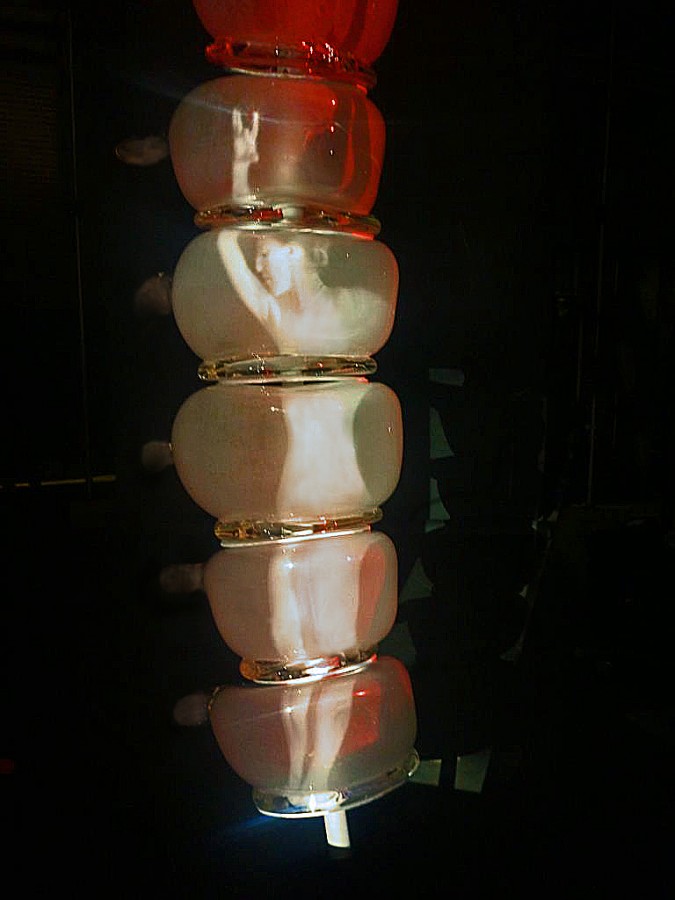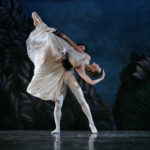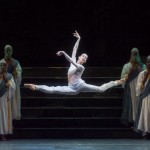Observing ABT dancers in company class on Wednesday, what struck me the most was not the 180-degree turn-out (ubiquitous), nor the extensions (extravagant), nor the pirouettes (I lost count), nor the men’s hands grazing the ceiling light fixtures every time they launched into an assemblé or grand jeté (we’re talking 16-foot ceilings at the ABT studios).
What leapt out at me was how the dancers held their backs – so strongly upright, even as their legs were lifting and circling. Ordinary mortals walk around thinking they’re standing up straight until they see a studio full of professional dancers and realize that they’ve actually spent their entire life hunched over.
Ballet develops not only strong back extensors, but also strong abdominals, exceptional mobility in the hips, and an ability to fine-tune one’s weight placement to avoid visible, aesthetically jarring compensations in the torso. In order to lift the leg to the back, for instance, an ordinary person would have to bend forward from the hips; a ballet dancer uses her strong spinal extensors to minimize this forward tilt and isolate it in the pelvis, moving the upper torso slightly forward and “lifting the heart,” creating the beautiful arch of an arabesque or attitude.
Because different sections of the spine curve in different directions, supporting it involves a delicate balancing act of muscular co-contraction. Dancers learn to engage the muscles around the spine in a precise way that protects it from injury, while creating a long lifted look. The abs must be pulled in just enough to protect the lumbar spine, but too much action from the abs can pull the ribs down, whereas too much extension of the thoracic spine (middle back) can draw the shoulders too far back.
Coincidentally, that same night, after being impressed by ABT’s spinal alignment, I came face-to-face with a gigantic spine – made of transparent glass – about 14 feet tall, with the moving image of a ballerina trapped within the glass, rippling her arms and reaching skyward. No, I had not had one glass of Margaux too many at the cozy La Lunchonette across from the High Line…
 This was an exhibition of steel and glass sculptures by the artist and jewelry designer Ippolita at the Highline Stages in New York, entitled Reliquary. Ippolita has reconceived the traditional reliquary – which in medieval times was an object of worship, a hollow carving, often in the shape of a body part, used as a vessel to hold real bones or other remnants of the departed – and into these graceful twisted blown-glass sculptures she had projected video images of dancers from New York Theatre Ballet. The otherworldly image of the beautiful Carmella Imrie undulating inside the iridescent glass was stirring yet perplexing –
This was an exhibition of steel and glass sculptures by the artist and jewelry designer Ippolita at the Highline Stages in New York, entitled Reliquary. Ippolita has reconceived the traditional reliquary – which in medieval times was an object of worship, a hollow carving, often in the shape of a body part, used as a vessel to hold real bones or other remnants of the departed – and into these graceful twisted blown-glass sculptures she had projected video images of dancers from New York Theatre Ballet. The otherworldly image of the beautiful Carmella Imrie undulating inside the iridescent glass was stirring yet perplexing –
Was the dancer trapped, perhaps signaling for help?
Was she taking shelter within the spine?
Did she and the spine together represent Whitman’s “body electric,” connecting the soul to the real world?
(Was she reminding me of my appointment with my chiropractor?)
New York Theatre Ballet, in contrast to ABT, is a tiny jewel of a company, with a reputation for offbeat and innovative programming that mainly features restorations of works by groundbreaking choreographers such as Ashton, Tudor, Cunningham, Limon and de Mille, but also showcases modern choreographers like Richard Alston.
Apart from ABT and NYTB, the best dancing in New York right now can be found on Broadway, specifically in the revivals of Anything Goes and How to Succeed in Business Without Really Trying. The dazzling Sutton Foster in the former and the hilarious John Larroquette in the latter lead superbly trained ensembles in inventive, highly caffeinated production numbers.
Ballet to the People rounded out her New York experience with ballet classes at the Ailey Extension in the Joan Weill Centre for Dance, a clean, warmly lit, modern facility that might as well be called ‘Dancer Heaven.’ The legendary Finis Jhung continues to teach a very pure and simple class that drills down on the principle of shifting your weight over your standing leg. Twenty-five years ago he exhorted me to “keep pushing down into the floor, don’t think of rising up” and “jump with your feet, not your legs” and today he reminded me, gently but firmly, to do the same. Though I grow old, his wisdom does not.







That sounds like a fabulous trip!! I’m a little jealous. 🙂
What sort of exercises outside of ballet class and pilates would you recommend dancers to do specifically to help strengthen their back, abs, and straighten their posture?
The structure of ballet class – with its progression of exercises from the barre to the centre, from pliés to tendus to dégagés and grands battements, gradually raising the leg higher and progressively challenging the stability of the torso and back – is itself the best, most efficient way to build strength and attain that truly straight posture. That said, you have to take class at least twice a week in order to make progress, and many recreational dancers either can’t fit this in or can’t find the right level of class more than once a week.
Swimming and yoga can strengthen the back and core – Iyengar may be the most appropriate form of yoga for dancers – but nothing beats Pilates, since it was developed specifically for dancers who are rehabbing from injury and who need to rebuild their strength, not just core strength but also strength in all the other muscle groups, including the smaller ones that are so important in ballet.
Anyone starting Pilates should work on the equipment before attempting mat classes. A common misconception is that Pilates mat classes are equivalent to working on Pilates equipment (the reformer, Cadillac, Wunda chair, barrels, etc.) However, most people are not strong enough for mat work until they have trained on equipment for a while. Unlike mat work, Pilates equipment provides an important element of stability, limits range of motion, enables better tracking, and allows you to increase/decrease resistance. Until you are able to maintain and move in and out of “neutral spine,” and can isolate the different muscle groups (for example, knowing when the psoas should kick in, or when the glute max or VMO should fire), mat classes are simply too challenging – yet many studios market them to beginners because they are cheaper for the student and more profitable for the studio.
Sadly, the cost of one-on-one Pilates lessons on equipment can be prohibitive for many students, but some enlightened studios which have the space and have made the investment in multiple set-ups offer small-group lessons on equipment, which are a good compromise for the student.
One unbeatable feature of the Pilates reformer for ballet students is the jump board – this allows you to jump while lying flat on your back. The varying resistance of the springs and a wide choice of jumps allow you to fine-tune the difficulty of your petit allegro workout. This is a very low-impact way to jump, which means that you can execute many more jumps safely than you can on the floor. You also rebound more slowly – almost like jumping in slow-motion – which allows you to focus on your core stability, foot articulation, the position of your feet in landing, the symmetry of your demi-plié, and your beats (a great workout for the inner thighs). And because you are lying down, your posture is naturally perfectly straight; getting used to this feeling really helps your posture when you stand up and jump.
10-15 minutes of non-stop jumping on the jump board is an intense workout – during which you can vary the type of jump, vary your foot position, and eventually add beats: royales, entrechat trois, quatres, cinqs and sixes. You are limited to non-traveling jumps, which is perfect for focusing on your core strength and stability.
Sweet ! And attending ttending a Finis Jhung Seminar is one of my (still) dream vacations 🙂
Wow, I had no idea there was even such a thing as Pilates “equipment” classes! You’ve just blown my mind!
Many studios that offer only mat classes – that haven’t made an investment in the equipment – don’t even tell their students that such a thing as Pilates equipment exists! But the full range and power of Pilates can really only be achieved using the equipment. Mat exercises are good to do at home, or in small spaces, but, as I mentioned earlier, are often too challenging for beginners. Once you work on the machines, a whole new world opens up and you can really speed up the pace at which you improve your strength and flexibility.
In that sense, while Pilates equipment classes are much more expensive than mat classes, your “return on investment” is almost always greater.